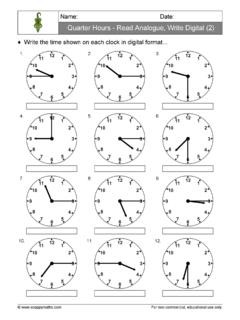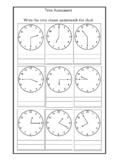Transcription of Functional Skills: Mathematics – Content mapping Edexcel
1 Functional Skills: Mathematics Content mapping Edexcel Key: New Content /requirement Content moved from a previously higher level in the current specifications Entry Level 1. DfE Subject Content Functional Skills: Place in current Edexcel Functional Skills Place in Pearson Edexcel GCSE (9-1) in Mathematics (Feb 2018) Mathematics 2010 Specifications Mathematics Specification Entry Level 1 using numbers and the number system whole numbers 1. read , write, order and compare numbers up to 20 Entry 1, presently to one significant figure N/A. 2. Use whole numbers to count up to 20 items Entry 1, presently to one significant figure N/A.
2 Including zero 3. Add numbers which total up to 20, and subtract Entry 1, presently to one significant figure N/A. numbers from numbers up to 20. 4. Recognise and interpret the symbols +, and = Not presently stated N/A. appropriately Entry Level 1 using common measures, shape and space 5. Recognise coins and notes and write them in Entry 1, presently to one significant figure N/A. numbers with the correct symbols ( & p), where Extra entry 2. these involve numbers up to 20. 6. read 12 hour digital and analogue clocks in hours Entry 2 N/A. 7. Know the number of days in a week, months, and Entry 2 and entry 3 Underlying knowledge seasons in a year.
3 Be able to name and sequence 8. Describe and make comparisons in words between Entry 1 N/A. measures of items including size, length, width, height, weight and capacity 9. Identify and recognise common 2-D and 3-D shapes Entry 1 N/A. including circle, cube, rectangle (incl. square) and triangle 10. Use everyday positional vocabulary to describe Entry 1 N/A. position and direction including left, right, in front, behind, under and above 1. Entry Level 1 handling information and data 11. read numerical information from lists Entry 2 N/A. 12. Sort and classify objects using a single criterion Entry 1 N/A. 13. read and draw simple charts and diagrams including Entry 3 N/A.
4 A tally chart, block diagram/graph Entry Level 2. DfE Subject Content Functional Skills: Place in current Edexcel Functional Skills Place in Pearson Edexcel GCSE (9-1) in Mathematics (Feb 2018) Mathematics 2010 Specifications Mathematics Specification Entry Level 2 using numbers and the number system whole numbers, fractions and decimals 1. Count reliably up to 100 items Entry 2, presently two significant figures N/A. 2. read , write, order and compare numbers up to 200 Entry 2, presently two significant figures N/A. 3. Recognise and sequence odd and even numbers up Entry 2, presently two significant figures Understand terms and use foundation to 100.
5 4. Recognise and interpret the symbols +, , x, and = Not presently stated Underlying knowledge appropriately 5. Add and subtract two-digit numbers Entry 2, presently two significant figures Underlying knowledge 6. Multiply whole numbers in the range 0x0 to 12x12 Entry 3 ( partial, only 2,3,4,5 and 10) Underlying knowledge (times tables). 7. Know the number of hours in a day and weeks in a Entry 3 and level 1 Underlying knowledge year. Be able to name and sequence 8. Divide two-digit whole numbers by single-digit whole Entry 3 ( partial, only 2,3,4,5 and 10) N/A. numbers and express remainders 9. Approximate by rounding to the nearest 10, and use Entry 3 N/A.
6 This rounded answer to check results 10. Recognise simple fractions (halves, quarters and Entry 3 N/A. tenths) of whole numbers and shapes 11. read , write and use decimals to one decimal place Entry 3 N/A. Entry Level 2 using common measures, shape and space 12. Calculate money with pence up to one pound and in Entry 2 and Entry 3 N/A. whole pounds of multiple items and write with the correct symbols ( or p). 2. 13. read and record time in common date formats, and Entry 2 N/A. read time displayed on analogue clocks in hours, half hours and quarter hours, and understand hours from a 24- hour digital clock 14. Use metric measures of length including millimetres, Entry1,2 and 3 Underlying knowledge centimetres, metres and kilometres 15.
7 Use measures of weight including grams and Entry 1,2 and 3 Underlying knowledge kilograms 16. Use measures of capacity including millilitres and Entry 3 Underlying knowledge litres 17. read and compare positive temperatures Entry 3 N/A. 18. read and use simple scales to the nearest labelled Entry 2 N/A. division 19. Recognise and name 2-D and 3-D shapes including Entry 2 and Entry 3 Foundation G4/G12. pentagons, hexagons, cylinders, cuboids, pyramids and spheres 20. Describe the properties of common 2-D and 3-D Entry 2, Entry 3 and Level 1 Foundation (vertices) G1. shapes including numbers of sides, corners, edges, faces, angles and base 21.
8 Use appropriate positional vocabulary to describe Entry 1 N/A. position and direction including between, inside, outside, middle, below, on top, forwards and backwards Entry Level 2 handling information and data 22. Extract information from lists, tables, diagrams and Entry 3 Underlying knowledge bar charts 23. Make numerical comparisons from bar charts Entry 3 N/A. 24. Sort and classify objects using two criteria Not in present specification N/A. 25. Take information from one format and represent the Level 1 (eg table to bar chart) N/A. information in another format including use of bar charts 3. Entry Level 3. DfE Subject Content Functional Skills: Place in current Edexcel Functional Skills Place in Pearson Edexcel GCSE (9-1) in Mathematics (Feb 2018) Mathematics 2010 Specifications Mathematics Specification Entry Level 3 using numbers and the number system whole numbers, fractions and decimals 1.
9 Count, read , write, order and compare numbers up Entry 3 presently 3 digit numbers N/A. to 1000 Level 1. 2. Add and subtract using three-digit whole numbers Entry 3 N/A. 3. Divide three-digit whole numbers by single and Entry 3 and Level 1 N/A. double digit whole numbers and express remainders 4. Multiply two-digit whole numbers by single and Entry 3 and Level 1 N/A. double digit whole numbers 5. Approximate by rounding numbers less than 1000 to Entry 3 and Level 1 N/A. the nearest 10 or 100 and use this rounded answer to check results 6. Recognise and continue linear sequences of numbers Entry 3 (partial) Foundation A23.
10 Up to 100. 7. read , write and understand thirds, quarters, fifths Entry 3 and Level 1 N/A. and tenths including equivalent forms 8. read , write and use decimals up to two decimal Entry 3 N/A. places 9. Recognise and continue sequences that involve Not in present specification Foundation A23. decimals Entry Level 3 using common measures, shape and space 10. Calculate with money using decimal notation and Entry 3 and Level 1 Foundation N13. express money correctly in writing in pounds and pence 11. Round amounts of money to the nearest 1 or 10p Not in present specification N/A. 12. read , measure and record time using am and pm Entry 3 and Level 1 N/A.












